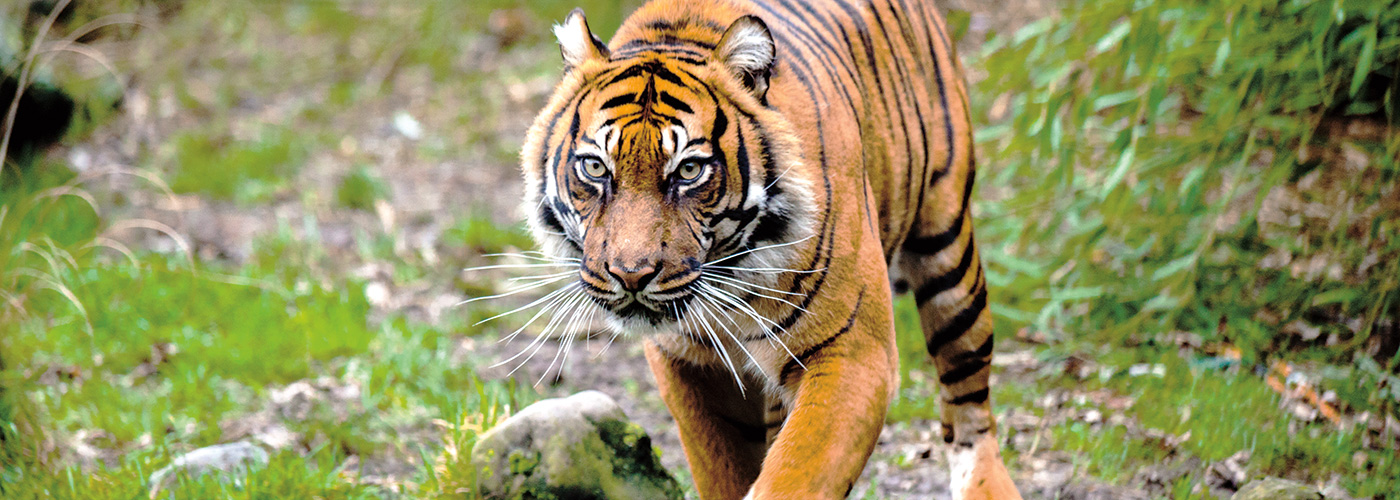Walking through a jungle in Thailand, John Goodrich saw signs of tigers everywhere. He could see track marks where the big cats had kicked their legs through the dirt. He could smell markings the predators had left on trees. Goodrich was visiting a region in Thailand where he knew a group of very rare Indochinese tigers lived. He wanted to answer one big question: Did the tigers have any cubs?

BIG CAT: An adult Indochinese tiger can weigh 400 to 550 pounds.
MCHEREVAN/123RF
Tracking Tigers
Scientists have found a group of tigers in Thailand—which could save the animals from extinction.
Looking for Tigers
Goodrich is a biologist with Panthera, a global wild cat conservation organization. He leads a team dedicated to protecting wild tigers from the threat of extinction.
Currently, there are about 3,900 tigers worldwide compared with about 100,000 a century ago (see Where Tigers Roam). There were once nine species of tigers, but today six remain. Only 220 Indochinese tigers are known to exist. If Goodrich could find tiger cubs, it would be an encouraging sign that the population of Indochinese tigers in the region could grow in number and thrive in the forest.
To investigate, Goodrich’s team partnered with Freeland, another conservation group. In 2017, scientists spent weeks trekking through the forest to place camera traps. These cameras record images of wildlife that come nearby. The team placed about 120 camera traps around the jungle where the tigers lived. To Goodrich’s delight, the cameras recorded a small group of 20 tigers—including at least 6 cubs! It was the first time cubs had been seen in the region in 15 years. “I was thrilled,” says Goodrich. “We knew we had to protect and help the population grow.”
Tigers in Trouble
The team’s discovery meant new hope for tiger populations. The decline in tigers worldwide is caused in part by poaching. Poachers sell tiger skins for decoration. These criminals also sell the bones to people who believe the bones have healing powers.
Another reason behind the tigers’ decline is habitat loss. People cut down forests where the animals live to make room for buildings and roads. The same people who cut down the trees sometimes also set snares to catch deer but accidentally catch tigers with the traps instead.
The Thai government is working to find and stop the poachers in the forest. Goodrich’s team has even helped install camera traps to catch poachers in the act. If a camera captures an image of a person, it immediately sends that photo to authorities.
COURTESY OF PANTHERA.ORG
CAUGHT ON CAMERA: Newly discovered Indochinese tiger cubs in Thailand
Hope for the Future
Goodrich’s team has continued to track the tigers over the two years since the cubs were discovered. He says the tigers are doing well. Their success is a sign that efforts by park rangers to protect the big cats is paying off.
Goodrich hopes that with this population of animals protected, Indochinese tigers will thrive in the region. He believes that the group of tigers his team discovered could increase to as many as 75. “The discovery of this small reproducing population is miraculous,” says Goodrich. “Tigers as a whole are struggling, but Thailand’s tigers are a sign of hope.”
Google Quiz
Click the Google Quiz button below to share an interactive version of the "Quick Quiz" with your class. Click Download PDF for the non-interactive skills sheet.
Download PDF